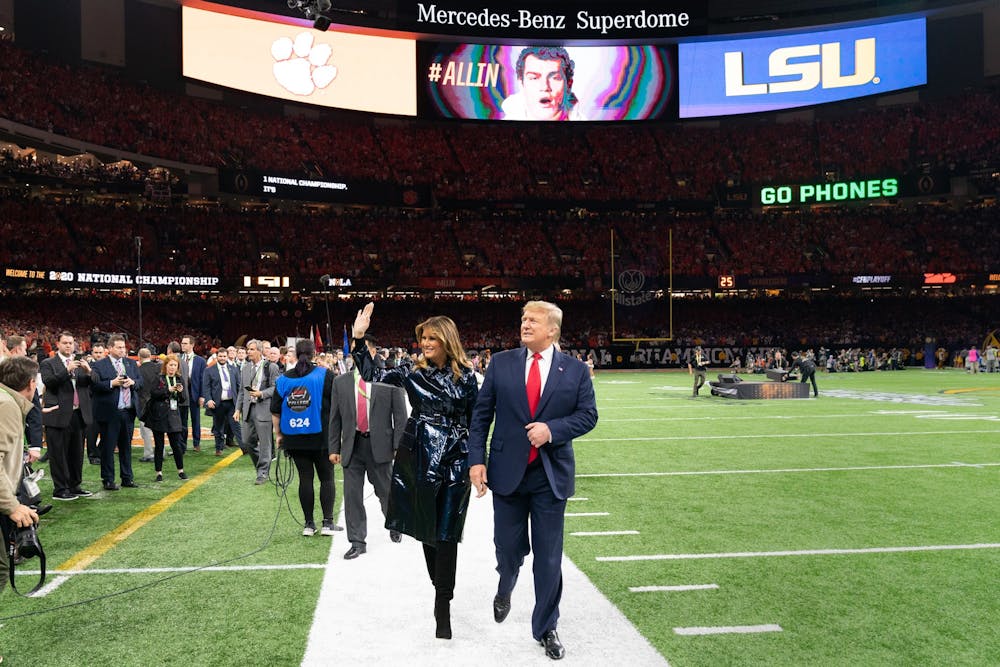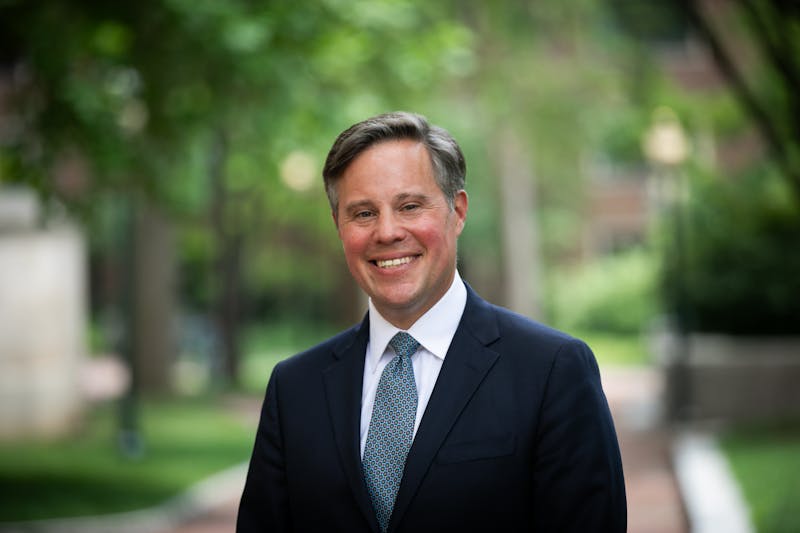
Photo by the White House
Donald Trump never changes.
The 1968 Wharton graduate's four years in the Oval Office have thus far been riddled with inconsistencies, contradictory statements, and lies. As one could expect, Trump’s long history with both professional and college football consists of much of the same.
The United States Football League was created in the early 1980s with the purpose of bringing professional football to audiences in the spring and summer. The NFL, college football, and even high school football all hold their seasons in the fall, meaning the USFL would be seizing upon a substantial opportunity in viewership.
The USFL successfully launched its first season in 1983 after receiving financial support via television contracts with ABC and ESPN. Immediately, reigning Heisman Trophy winner and future Hall of Famer Herschel Walker became the star of the league for the New Jersey Generals.
The USFL’s plan was working: television ratings and league attendance surpassed initial expectations. The business model — centered around avoiding direct competition with other football leagues — was appropriate and captured a niche of dedicated football fans who lamented the long offseasons.
Armed with a great strategy, budding talent, and the proven popularity of football, how did the USFL only last until its third season in 1985? The answer is simple: Trump.
Concurrent with the origins of the USFL, Trump, a 37-year-old real estate hotshot, was looking to barge his way into the coveted ring of NFL owners. He made multiple bids for partial ownership of NFL teams that began in the early 1980s and continued for decades to come. However, he was rejected each time on the grounds of competency and financial solvency issues.
But Trump was relentless. His motto became, “If you can’t join, beat them.”
After backing out of a deal for the team in 1982, Trump became the owner of the Generals as a result of a $9 million purchase in 1983. Trump’s media antics, interviews, and signings quickly drew attention, along with a variety of monumental team decisions.
The coach of the team was promptly fired, and Trump targeted legendary Dolphins coach Don Shula, but the deal fell apart when Shula insisted on being partially compensated with a free room at Trump Tower.
Trump then shifted gears towards another NFL coach; this time he successfully bargained to steal Walt Michaels away from the New York Jets.
“We’re not at peace with the NFL,” Trump said in an interview. “We’re in a form of war with the NFL right now, there’s no question about it.”
Trump also plucked several players from the NFL, including wide receiver Tom McConnaughey, quarterback Brian Sipe, defensive back Gary Barbaro, and linebackers Jim LeClair and Bobby Leopold.
The Generals made more headlines in 1985 with the signing of quarterback Doug Flutie. The team even managed to sign one of the greatest linebackers of all time in Lawrence Taylor, though he would need to finish playing the few years left in his NFL contract first. Though other owners wanted to enforce a salary cap on the league, Trump’s spending made these conversations irrelevant.
None of this was close to enough to satisfy Trump’s ego, who ultimately suggested a move to the fall to compete with the NFL, directly defying the USFL’s original intent. Though the USFL was intended to avoid conflict with the NFL, Trump would stop at nothing to force a merger between the two leagues, basing his idealism on the NFL-AFL merger in 1970.
For those who were familiar with Trump and his personal goals, it was clear that the Generals were merely a stepping stone for Trump’s ambitions and a new way to maneuver his way into the NFL.
The nail in the coffin for the USFL was a Trump-led lawsuit that alleged that the NFL was in violation of antitrust law due to its monopoly on football. The USFL nominally won the case, but it was awarded only $1 in damages. This became $3 because antitrust compensations are trebled and eventually totaled $3.76 with interest.
“I got this league to go as far as it could go,” Trump said. “Without me, this league would have folded a lot sooner.”
Alas, the USFL was unable to stay afloat financially, and in 1985, after just three seasons, the USFL never played another down.
“It was a hard thing to watch unfold,” said Jerry Argovitz, owner of the Houston Gamblers. “Donald didn’t love the USFL. To him, it was small potatoes. Which is terrible, because we had a great league and a great idea. But then everyone let Donald Trump take over. It was our death.”
Trump’s escapade with the USFL sparked his rocky relationship with the NFL, but things were just getting started. Unwilling to take responsibility or admit his faults, Trump went to extraordinary lengths to cover up his failure.
“I could have gotten into the NFL a lot easier than going through this exercise,” Trump said. “I could have spent the extra money and bought the Colts on many occasions.”
As early as 1986, less than a year removed from his USFL schemes, Trump vied for an expansion team in New York, vouching his case to NFL commissioner Pete Rozelle. Rozelle vividly recalled one meeting with Trump in which he took careful notes and paid attention to what misleading arguments he would be presented.
“Mr. Trump, as long as I or my heirs are involved in the NFL, you will never be a franchise owner in the league,” Rozelle said in that meeting.
In 2014, Trump lost yet another bid for partial ownership of a team, this time trying to buy the Buffalo Bills. Despite never managing to become a member of the exclusive owners’ club, Trump continues to boast about his close relationships with owners such as Robert Kraft of the New England Patriots, Jerry Jones of the Dallas Cowboys, Dan Snyder of the Washington Football Team, and others.
Nine NFL owners donated to support his 2016 presidential campaign, including $7.7 million for Trump’s inauguration.
His controversies with the NFL continued during his presidency. In 2017, when quarterback Colin Kaepernick decided to kneel during the national anthem in protest of police brutality and racial injustice, Trump responded by calling players who knelt “sons of bitches.”
Trump’s vocal criticism extended to the NFL itself, as he vehemently rebuked the league for not reprimanding players who knelt more harshly and called for the NFL to instate new rules.
After the murder of George Floyd, Trump anticipated more kneeling by players and stated that he would rather not have the NFL return to action if that was the case. The NFL made rule changes that accommodated kneeling players, requiring them to stay in the locker room during the national anthem.
More recently, Trump has loudly supported the return to college football, especially in the Big Ten, despite surging coronavirus cases throughout the country.
Though the Big Ten initially announced it would not be holding a season, Trump worked tirelessly to ensure the proper funding for testing and safety protocols was provided. The conference reversed its decision and returned to the field this October.
Its opening weekend fostered mixed results. Games were carried out across the conference, but 12 members of Wisconsin's team tested positive for COVID-19 in the past week, including standout quarterback Graham Mertz.
Trump’s relationship with football leagues at different levels continues to evolve to this day. His stances, particularly in regards to the NFL, tend to shift according to whatever suits his personal interests at the time, whether it be as an USFL owner, an aspiring NFL owner, or the President of the United States.
Across a four-decade history, one of the only constants about Trump’s position towards the NFL is his inconsistency.
The Daily Pennsylvanian is an independent, student-run newspaper. Please consider making a donation to support the coverage that shapes the University. Your generosity ensures a future of strong journalism at Penn.
Donate






